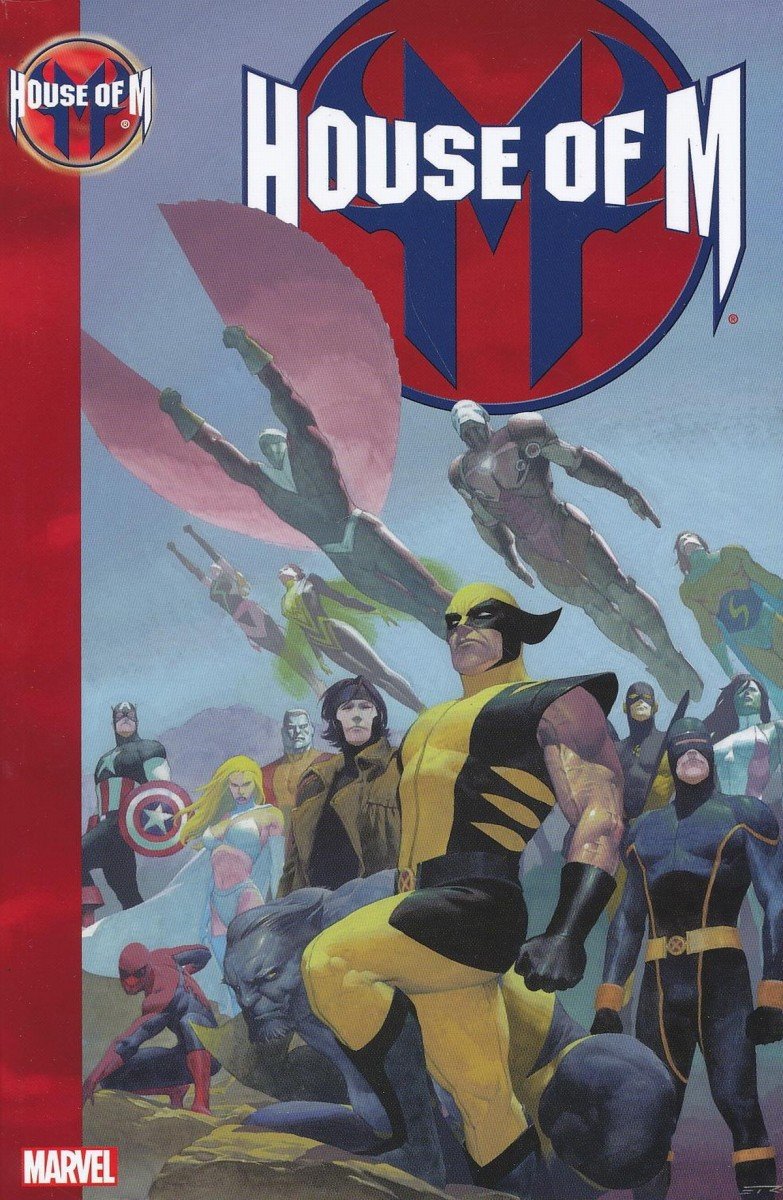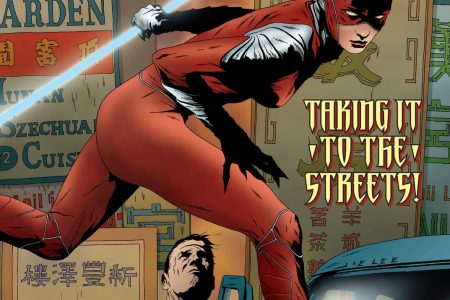House of M #1–8 by Brian Michael Bendis & Oliver Coipel
A series where I knew the result (‘No more mutants’) without reading the actual comic books themselves, I wanted to read this because I enjoy Bendis’ work and I quite like alternate timeline stories. Now that I’ve read it, I realised I didn’t need to read it; the end result is the same.
The book collects eight issues, but you get the feeling that it didn’t need them. Accusations of ongoing series padding out the story for the trade don’t seem appropriate for a mini-series, but this collection d-r-a-g-s: the first issue takes the entire length to get round to the point (namely, Wanda changing the universe with her reality-altering powers after the events of the Avengers: Disassembled storyline).
The second issue is setting up the alternate world, which is the fun part: Steve Rogers is an old man, a war veteran; Scott Summer and Emma Frost are happily married; Alison Blaire is a TV chat show host; Simon Williams is a film star; Carol Danvers is the most popular superhero; Kitty Pryde is a teacher; Sam Wilson is a cop; Luke Cage is an underworld boss; Stephen Strange is a psychologist; Piotr Rasputin is a Russian farmer; Hank McCoy and Hank Pym are scientists for Tony Stark, who is the only non-mutant industrialist; Janet van Dyne is a fashion designer; Logan, who has stupid hair, is a top agent of SHIELD, who has Rogue, Kurt Wagner and Jessica Drew as part of his team (for more characters see this page, which provides more background information not in the book). It is Logan who kickstarts the actual plot: he remembers not only everything but also the fact that this mutant-utopia is not the real universe – he jumps off the SHIELD aircarrier (in a rather cool shot) to land in Manhattan below.
In the third issue, Logan tries to find Xavier but can’t find him, so goes to see Stark, only to be jumped by his own SHIELD team. He is rescued by Cloak under instruction from Luke Cage, and we see an alive Clint Barton. The fourth issue sees Logan explain everything and we learn about Layla, who not only remembers as well but also has the ability to restore people’s memories. The fifth issue is Layla restoring the memories of Scott, Peter Parker (who is angry to discover the fallacy of his existence, especially the happiness of it), Strange, Kitty, Danvers, Stark, Matt Murdoch, Jennifer Walters, Rogue, Kurt and Jessica Drew.
The sixth book sees them go to Genosha, home of Magneto’s House of M, getting into a fight as a distraction for Layla to restore Charles Xavier’s memory, except he is dead. There is more fighting in the seventh issue, and it is revealed that it was Pietro, not Magnus, who persuaded Wanda to change the world to what they always wanted. Magnus kills Pietro when he finds out, which causes Wanda to snap – she revives Pietro and says the words, ‘No more mutants’. The final issue sees the result of this: the world is back to normal and there are only 10% of the previous number of mutants – the rest are sapien, including Bobby Drake and Magneto. Only the people in the psychic shield of Dr Strange remember the events of the House of M (and there is a two-page set-up for the quite dire The Collective storyline in The New Avengers, which was a huge misfire from Bendis).
The trouble with the story, apart from the slow pace, is that it feels like it was a story needed to accomplish a dictate, namely the reduction of mutant numbers (it has to be said that mutants were becoming increasingly common, rather than the actual minority they were supposed to be). Interviews with Bendis about House of M suggested that it was an outgrowth of the Wanda story in the Avengers that was going to occur in The New Avengers, but it doesn’t feel organic. This leaves a sour taste in the mouth – you feel as if you’ve read eight issues of troubleshooting/tidying up of the Marvel Mutant Universe.
This is not to say it is all bad – Bendis as ever has a nice touch with dialogue, with a natural feel that stays true to the character, and he has put a lot of thought into the alternate universe: there has been a lot of research and there are plenty of Easters eggs (a cameo for Gambit and lots of mutant names are overheard in the radio chatter on the SHIELD air carrier, such as Garrison Kane). The story is well constructed, although it helps to read in one sitting – it would have driven me crazy to wait eight months for events to unfold – but it all connects and reflects character choices within the narrative.
Coipel’s art is good superhero work, even if some of the inkers don’t quite fit his style – the middle chapters of the story are slightly off. He has a strange width to his male characters – he has increased the classical anatomical proportions so that the chest/shoulder/legs are stretched width-wise, which makes them more heroic. He has a funky angular quality to his figures, and he moves the action around interestingly, keeping the camera set-ups visually engaging. As I’ve said about other superhero artists in other reviews recently, he suffers from the malaise of over-sexualisation of female characters – in his case, it is an obsession with breasts: he has Emma Frost’s breasts falling out of the shirts she wears, and there is a double-page spread of the attack on Genosha where She-Hulk’s breast has escaped from a badly zipped top. It’s a shame because his work is enjoyable otherwise (and his art is superior to the rather dull and flat covers that accompanied the book).
I don’t want to seem like a grouchy old comic book fan, but the Marvel obsession with huge crossovers (there were over a dozen mini-series and tie-in books to the main event) is very tiring. What happened with just telling a good story? I’m glad to have read the book, but I’m also glad that I didn’t let my fondness for Bendis’ work compel me to buy this as it came out at the time. Not a satisfactory reading experience. And surely there is no connection to Secret Invasion here?




